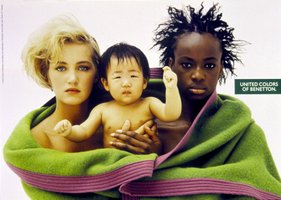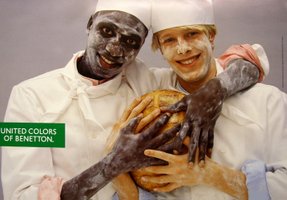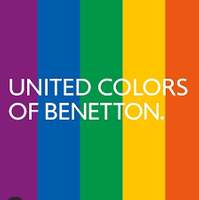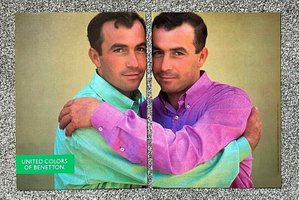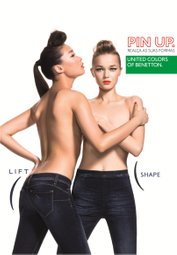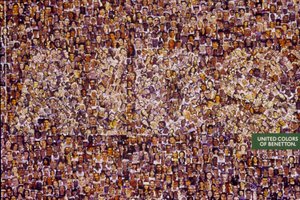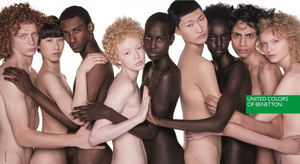Marketing the Rainbow
Click on pictures for larger image.
Case Study: Benetton
branche: Fashion
Article last updated May 1, 2022
The outline
Like many fashion brands, Benetton used images that could easily be interpreted as gay. They sometimes were explicitly meant as such.
The 1990 image "Blanket" suggests an interracial, homosexual family at a time when advertising was almost devoid of such depictions. Until a few years ago, most images of lesbian relationships used for advertisement were fetishised or heavily sexually suggestive.
In 2020, Toscani was fired again, this time over comments he made about the 2018 collapse of the Morandi Bridge in Genoa (which was largely owned by the Benetton Group).
2019: Jean-Charles de Castelbajac
In 2019 Jean-Charles de Castelbajac became the new artistic director of United Colors of Benetton. He released a limited edition capsule with unisex models that celebrated the rainbow as a sign of hope. The rainbow was not exactly the 6-colored LGBT one though, although it was hailed by sites like gay.it as a Pride collection.
2018: about Gender
Seventeen years after Toscani was let go in 2000, he was re-appointed in the same role at the company. His 2018 campaign featured a characteristically diverse cast of models, holding colourful bouquets and wearing T-shirts emblazoned with phrases like “colours don’t have gender” and "gender free zone".
There also was a campaign in Turkey, where both gender roles and LGBT have been under attack.
2013: Lea T
In 2013, Brazilian transgender model Lea T was featured in the Spring/Summer campaign. The press: "United Colors of Benetton is aligning the social issues it features in brand advertising with its product campaigns for the first time, through activity starring both a trans-sexual and disabled model." Another journalist wrote: "The company's history of deliberately shocking ads is so long that most people yawn when confronted by the clothing retailer's latest manufactured outrage. Which is why it's so refreshing to see Benetton return to the simple act of selling clothes in its ads, like this one featuring Lea T."
How it began: the Toscani effect
Benetton has always prioritised the inclusion of everyone, regardless of gender, race or sexuality. In 1982, they hired Oliviero Toscani as creative director, which led to a change in advertising focus towards raising awareness for various issues worldwide. Over 30 years before our current diversity boom, in 1984, Toscani photographed the first multiracial ad for the line. He did it with so-called shockvertising: provocative, socially progressive ads that spurred outrage and drew headlines.
In 1985 he made the picture on the right of the two 'baker friends'. In 1989, Toscani refocused Benetton's advertising strategy under the "United Colors of Benetton" campaign. The campaign's graphic, billboard-sized ads depicted a variety of shocking subjects, including the deathbed scene of a man dying from AIDS (see below). It led to calls for a boycott of the ad by The Sunday Times and fashion magazines Elle, Vogue and Marie Claire refusing to run it.
UNHATE campaign, 2011
In 2011 they launched the global Unhate Campaign: they invitef the leaders and citizens of the world to combat the “culture of hatred” and created the UNHATE Foundation. The central theme of the project was the kiss, the most universal symbol of love, between world political and religious leaders, such as: Barack Obama and Chinese leader Hu Jintao; Pope Benedict XVI and Ahmed Mohamed el-Tayeb, Imam of the Al-Azhar mosque in Cairo; the Palestinian president Mahmoud Abbas and the
The Italian fashion brand has been a trailblazer from the word Go. Their images and campaigns have broken barriers, became the hot topic of many conversations, attracting criticism from all sides - but at the same time paid attention to minorities, including LGBT. Their contribution to AIDS awareness has been immense. Because of their "United Colors of Benetton" the rainbow has always shone through in their products and their campaigns, one way or another. They never needed to 'make a statement' with a special Pride collection. Benetton has been (almost) uncompromising and consistent: a creative and colorful ally who gets a 9/10 (it would have been 9.5 when they would have supported an LGBT charity).
2016: Egalitarian Love
This 2016 campaign shocked, positively, for its simplicity and its message. Made with the art direction of the Braga + Federico studio and shot by Giulio Rustichelli, it had been announced by a video on Benetton's official Instagram profile in February and it was placed in a blow-up at Termini station in Rome, one of the most popular crossroads of the capital, as well as in Madrid.
© 2022 BRIGHT Marketing Solutions
In November 1990 LIFE Magazine published journalism student Therese Frare’s image of gay activist and AIDS victim David Kirby as he lay on his death bed. His body wasted by AIDS, his gaze locked on something beyond this world surrounded by anguished family members as he took his last breaths: a kind of Pietá. The haunting image of Kirby on his death bed quickly became the one photograph most powerfully identified with the HIV/AIDS epidemic.
Two years later Benetton used the image, coloured by artist Ann Rhoney with oil paint, for its campaign. Despite a backlash by many AIDS activists who believed it spread fear of sufferers and commoditised suffering, and launched a global campaign to boycott the company, Kirby’s father Bill stated, “Benetton is not using us, we’re using Benetton…If that photograph helps someone… then it’s worth whatever pressure we have to go through.” It
was, according to Benetton, the first public campaign to address AIDS. That year the disease had become the number one cause of death for US men aged 25 to 44. Benetton claimed it wanted to “go beyond purely preventative measures and touch upon subjects such as solidarity with AIDS patients”.
Life called it "The Photo That Changed the Face of AIDS". By some estimates, as many as one billion people have seen the now-iconic Frare photograph.
Israeli prime minister Benjamin Netanyahu. These were symbolic images of reconciliation - with a touch of ironic hope and constructive provocation. While highly praised, with it winning the Cannes Ad Festival award, the picture of the pope kissing a Muslim leader was condemned by the Vatican.
Both famous and infamous, the striking visuals of their adverts (at times entirely bereft of any reference to their products), political posturing and diverse roster of models made them influential in both fashion and pop culture. Although many ads never featured any of the label’s clothing, they brought the Benetton name front and center as a source of debate and inspiration.
Toscani was let go in 2000, after a controversial campain with death row inmates. Seventeen years later, he was re-appointed in the same role. This advertisement from 1995 can be labelled as 'gay', but obviously features identical twins.
Life in Italy: "Even if you don’t know much about the Benetton brand of clothing, you’ve likely seen their advertisements. Benetton ads have caused a stir across the globe. They are earning acclaim and awards, as well as contempt and censorship for their controversial subject matter. Before becoming an international sensation, the united colors of Benetton brand had humble beginnings in Ponzano Veneto, Italy. It started as a small family business. They have numerous colorful collection debuts at Milan Fashion Weeks, actively involving themselves in numerous social causes, celebrates essential values: diversity, inclusion, and sustainability." They also gave attention to gender and racial inequality, domestic violence, hunger, natural disasters, war, refugees, religious bias and child marriage and pregnancies.
1995 Best Dress
AdRespect: Fast-paced cuts and movements go by as the model talks about her 'best dress,' the one "you love more than your boyfriend - but let's not get started on that."
This spot could go by entirely innocuously, were it not for the fact that that Asian model Jenny Shimizu is an out lesbian. That makes her previous line funny - when you're in the know!
UNHATE campaign, 2014
In 2014 they announced a collaboration with the United Nations to make ten ‘good news’ initiatives a reality. Among the initiatives was an imagined gay pride event on Moscow’s Red Square.
Benetton’s UNHATE Foundation and FABRICA commissioned marc & ish to create a number of projects for their notorious UNHATE campaign. They created fictitious "found" footage of an imagined Gay Pride celebration in Red Square. The film imagines one of the participants filming Gay Pride in Red Square for his lover because he can't believe his eyes. The courts in Moscow banned Gay Pride from being held in the city for the next 100 years. This institutionalised homophobia in Russia was exposed during the build up to and during the Sochi 2014 Winter Olympics.
Pin Up: 2012
The Benetton Pin Up denim line was designed with a technology that allows apparel design to be crafted to highlight your best bits and diffuse the rest. Comprising two separate lines - Shape and Lift - the Benetton Pin Up Denim collection offers jeans that are specifically designed to enhance a woman's curves. The campaign pictures featured half naked women in semi-intimate poses.
Conclusion
HIV/AIDS awareness: The Photo That Changed the Face of AIDS
They had used a picture of many colors of condoms in 1991, also as an awareness campaing for AIDS. In collaboration with Okamoto, one of the top selling Japanese condom brands, they released a set of colorful condoms (pink and green). It came in few different cool packages thatno one would think as a condom package (thus you don't have to 'hide it somewhere in your room'). There also was a condom vending machine with Benetton branding.
In 1993 we saw naked bodies with the stamp "HIV positive". Various AIDS groups sued Benetton over their “commercial exploitation of suffering” and a French court fined them $20,000 for it.
In the same year they showed a sea of many faces with the word "AIDS" hovering specter-like among them.
The 2018 autumn-winter campaign gave us a poster where you can see a group of boys and girls - in fact sometimes gender neutral - of different ethnic groups, completely naked, embracing, mingling. The values underlying the image are "diversity, equality and an idea of the future that is more urgent than ever, against all resurgent racisms", according to the video that launched the image.
2018: Nudi
Benetton x Depop, 2021
Depop and Benetton joined forces for a collaboration that celebrated shared essential values: diversity, inclusion and sustainability. Depop is a peer-to-peer social e-commerce company (now owned by Etsy) that allows users to buy and sell items, most of which are used and vintage pieces of clothing.
The diversity in this video takes difference forms, including Queer. A campaign featuring @YouthClubStore, @ArchiveSix, @Ayo and @Hadiyahh.
Introduction
Benetton Group is a global fashion brand based in Ponzano Veneto, Italy - founded in 1965. It has a network of about 5,000 stores worldwide. The company's core business consists of clothing brands United Colors of Benetton and Sisley.
